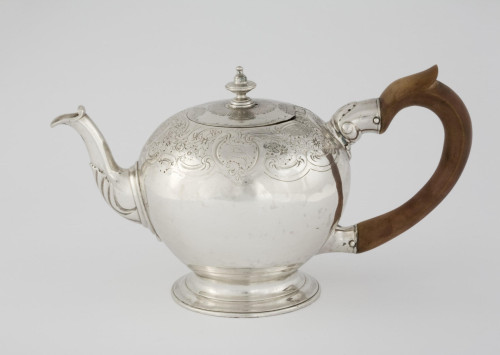85/1996
Collection
Metalwork
Brief description
Silver teapot with chased and engraved decoration and a wooden handle, made by Benjamin West in London between 1744 and 1745. It is marked on the base with the sterling, assay, sponsor and date marks - the lion passant, leopard's head, initials 'BW' and letter 'i'.
Object name
teapot
Object number
85/1996
Location
On Display
Production person
Benjamin West (maker)
Production date
1744-1745 (made)
Production place
London (made)
Period
Georgian (1714-1837)
Material
silver
wood
wood
Technique
carved
chased
hammered
chased
hammered
Physical description
Silver teapot of bullet form, chased around the shoulder with rococo ornament of scrolls and flowers, spreading foot with later wood handle. Sponsor's mark BW for Benjamin West, date letter i for 1744-5, leopard's head and lion passant. Inscriptions on base '6894' twice, 'No7614' and 'PB/3[?] 432 gross 13.05'.
Dimensions
Height: 11.8cm
Width: 20.3cm
Width: 20.3cm
Website keywords
Eating, drinking and smoking
serving drink
tea, coffee and chocolate drinking
serving drink
tea, coffee and chocolate drinking
Label
Label text for ‘A taste of China’ case, Information Bay 3, Geffrye Museum, 2010:
Teapot, 1744–5
Silver, bearing the mark of Benjamin West
Many early teapots, coffee pots and chocolate pots were made of silver, a mark of their owners’ status and an indication of how highly prized these new hot drinks were.
At first, tea was recommended as a medicinal drink. It was usual to sweeten such herbal tonics with sugar, and this improved the taste of tea so much that it was soon drunk for its own sake. Refined white sugar was used by those who could afford it, whilst brown sugar, molasses or treacle were cheaper alternatives.
Teapot, 1744–5
Silver, bearing the mark of Benjamin West
Many early teapots, coffee pots and chocolate pots were made of silver, a mark of their owners’ status and an indication of how highly prized these new hot drinks were.
At first, tea was recommended as a medicinal drink. It was usual to sweeten such herbal tonics with sugar, and this improved the taste of tea so much that it was soon drunk for its own sake. Refined white sugar was used by those who could afford it, whilst brown sugar, molasses or treacle were cheaper alternatives.












